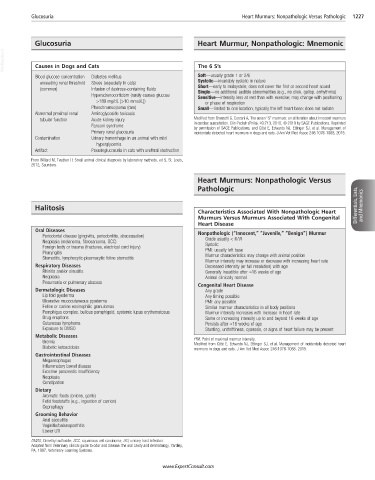Page 2471 - Cote clinical veterinary advisor dogs and cats 4th
P. 2471
Glucosuria Heart Murmurs: Nonpathologic Versus Pathologic 1227
Glucosuria Heart Murmur, Nonpathologic: Mnemonic
VetBooks.ir Causes in Dogs and Cats The 6 S’s
Blood glucose concentration Diabetes mellitus Soft—usually grade 1 or 2/6
exceeding renal threshold Stress (especially in cats) Systolic—invariably systolic in nature
(common) Infusion of dextrose-containing fluids Short—early to midsystole; does not cover the first or second heart sound
Single—no additional audible abnormalities (e.g., no click, gallop, arrhythmia)
Hyperadrenocorticism (rarely causes glucose Sensitive—intensity less at rest than with exercise; may change with positioning
>180 mg/dL [>10 mmol/L]) or phase of respiration
Pheochromocytoma (rare) Small—limited to one location, typically the left heart base; does not radiate
Abnormal proximal renal Aminoglycoside toxicosis
tubular function Acute kidney injury Modified from Bronzetti G, Corzani A. The seven “S” murmurs: an alliteration about innocent murmurs
in cardiac auscultation. Clin Pediatr (Phila). 49:713, 2010, © 2010 by SAGE Publications. Reprinted
Fanconi syndrome by permission of SAGE Publications, and Côté E, Edwards NJ, Ettinger SJ, et al. Management of
Primary renal glucosuria incidentally detected heart murmurs in dogs and cats. J Am Vet Med Assoc 246:1076-1088, 2015.
Contamination Urinary hemorrhage in an animal with mild
hyperglycemia
Artifact Pseudoglucosuria in cats with urethral obstruction
From Willard M, Tvedten H: Small animal clinical diagnosis by laboratory methods, ed 5, St. Louis,
2012, Saunders.
Heart Murmurs: Nonpathologic Versus
Pathologic
Halitosis Differentials, Lists, Differentials, Lists, and Mnemonics and Mnemonics
Characteristics Associated With Nonpathologic Heart
Murmurs Versus Murmurs Associated With Congenital
Heart Disease
Oral Diseases Nonpathologic (“Innocent,” “Juvenile,” “Benign”) Murmur
Periodontal disease (gingivitis, periodontitis, abscessation)
Neoplasia (melanoma, fibrosarcoma, SCC) Grade usually < III/VI
Foreign body or trauma (fractures, electrical cord injury) Systolic
Pharyngitis PMI: usually left base
Stomatitis, lymphocytic-plasmacytic feline stomatitis Murmur characteristics may change with animal position
Murmur intensity may increase or decrease with increasing heart rate
Respiratory Diseases Decreased intensity (or full resolution) with age
Rhinitis and/or sinusitis Generally inaudible after ≈16 weeks of age
Neoplasia Animal clinically normal
Pneumonia or pulmonary abscess Congenital Heart Disease
Dermatologic Diseases Any grade
Lip fold pyoderma Any timing possible
Ulcerative mucocutaneous pyoderma PMI: any possible
Feline or canine eosinophilic granulomas Similar murmur characteristics in all body positions
Pemphigus complex, bullous pemphigoid, systemic lupus erythematosus Murmur intensity increases with increase in heart rate
Drug eruptions Same or increasing intensity up to and beyond 16 weeks of age
Cutaneous lymphoma Persists after ≈16 weeks of age
Exposure to DMSO Stunting, unthriftiness, cyanosis, or signs of heart failure may be present
Metabolic Diseases PMI, Point of maximal murmur intensity.
Uremia Modified from Côté E, Edwards NJ, Ettinger SJ, et al. Management of incidentally detected heart
Diabetic ketoacidosis murmurs in dogs and cats. J Am Vet Med Assoc 246:1076-1088, 2015.
Gastrointestinal Diseases
Megaesophagus
Inflammatory bowel disease
Exocrine pancreatic insufficiency
Neoplasia
Constipation
Dietary
Aromatic foods (onions, garlic)
Fetid foodstuffs (e.g., ingestion of carrion)
Coprophagy
Grooming Behavior
Anal sacculitis
Vaginitis/balanoposthitis
Lower UTI
DMSO, Dimethyl sulfoxide; SCC, squamous cell carcinoma; UTI, urinary tract infection.
Adapted from Veterinary clinical guide to odor and disease: the oral cavity and dermatology, Yardley,
PA, 1997, Veterinary Learning Systems.
www.ExpertConsult.com
www
.ExpertConsult.com

